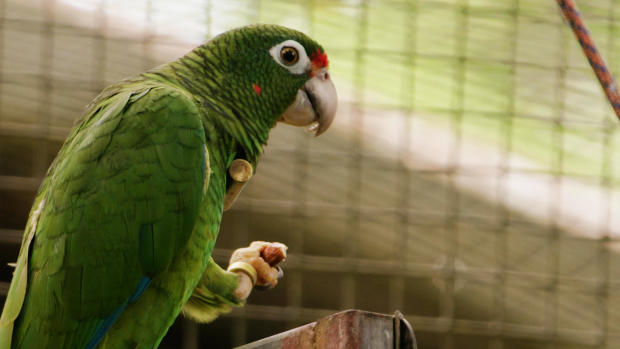Puerto Rican parrot threatened by more intense, climate-driven hurricanes
There were 56 wild, endangered Puerto Rican parrots living around El Yunque National Forest before Hurricane Maria in 2017. After the storm, there was only one survivor.
"I'll admit that a couple of times I just cried," said Tom White, a biologist with the U.S. Fish and Wildlife Service, who's been working for 30 years to re-establish a wild Puerto Rican parrot population at El Yunque.
The parrot is one of the most critically endangered birds in the world, according to the International Union for Conservation of Nature and Natural Resources.
About 60 years ago, the U.S. Fish and Wildlife Service listed the parrot as an endangered species, a legal status that has resulted in a continuous and challenging effort to rebuild a healthy population of birds in the wild that continues today.
"If human beings have caused it, it is basically incumbent upon us to fix it," White said.

But the Puerto Rican parrot is also one of the many species whose habitat and survival is threatened by hurricanes, which are becoming more and more destructive due to climate change.
Hurricane Maria killed almost 3,000 people, causing historic floods and landslides. Researchers found Maria's extreme rainfall was 5 times more likely because of climate change.
Battered by 175 mph wind speeds, White and his wife rode out the storm inside a hurricane shelter with 120 captive, breeding pairs of parrots, protecting them from the storm. Afterwards, they went outside to survey the damage.
"We were speechless," he said. "It went from being green and lush to brown and defoliated in a question of hours."
- See more stories about how scientists are trying to protect life on Earth
All the captive birds White had in the hurricane shelter survived the storm. But because of heavy debris, crews could not reach the 56 wild birds that had previously been released and were living in remote areas of the forest.
While some of those wild parrots were killed by hurricane winds, many more died of starvation after the storm, with the island's forests stripped bare of vegetation.
"There was nothing for them to eat," said Marisel López Flores, leader of the Parrot Recovery Program.
Birds in crisis
Around the world, birds are in crisis — and not just exotic ones. Over the last 400 years, nine bird species in North America have gone extinct, according to the National Audubon Society. Within this century, the group estimates 314 species are threatened with extinction.
Some of the largest declines, according to a landmark study from the Cornell Lab of Ornithology, are happening in the most common types of birds. The study looked at population decline between 1970 and 2019 and found major losses of:
Wood thrushes, found across the eastern U.S.; 60% of them are gone.
Baltimore orioles, also an eastern bird; two-fifths have been lost.
Western meadowlarks, prevalent in the central and western U.S.; three-fourths have disappeared.
Some of the major threats to birds come from habitat loss and global temperature rise. But more intense hurricanes also play a role.
While many birds are adapted to survive major storms, they may struggle to overcome damage to their habitats that are needed to nest, forage and roost — which is what happened to many Puerto Rican parrots.
White explained that protecting the habitats of the parrots can also protect the habitats of thousands of other species.
"By doing so, you protect the world for many others at the same time," he said.
Giving the birds a better chance
Since Hurricane Maria, the U.S. Fish and Wildlife Service is successfully reestablishing a wild population of parrots, now with a new twist.
Before the hurricane, the birds were released into remote corners of El Yunque. Now, scientists and staff use behavioral techniques that encourage the birds to stay close to the aviary complex.
Essentially, this combines wild and captive birds into a single community at the aviary. In future disasters, this may give the birds a better chance of being rescued and fed when the forest is impassable.
Biologists developed this technique at a sister parrot aviary in Puerto Rico, at Rio Abajo State Forest, where, after Maria, they were able to feed 90 birds and save their lives. The techniques developed in Puerto Rico have since also been successfully used in the release of endangered macaws in Brazil.
Tom White, the U.S. Fish and Wildlife biologist, said birds survive better with larger flock sizes.
"Flocks defend against predators and also to better find food resources," White said.
In January, the aviary in El Yunque released 22 birds from captivity. Between three aviary locations across Puerto Rico, today there are about 300 parrots living in the wild, a sign that the parrot recovery efforts here are working.
"When I'm old and I die, I can say I did something for my country. This is the way I think I'm contributing to my island," said López Flores.
- In:
- Climate Change
- Puerto Rico
David Schechter is a national environmental correspondent and the host of "On the Dot with David Schechter," a guided journey to explore how we're changing the earth and earth is changing us.
Disclaimer: The copyright of this article belongs to the original author. Reposting this article is solely for the purpose of information dissemination and does not constitute any investment advice. If there is any infringement, please contact us immediately. We will make corrections or deletions as necessary. Thank you.






